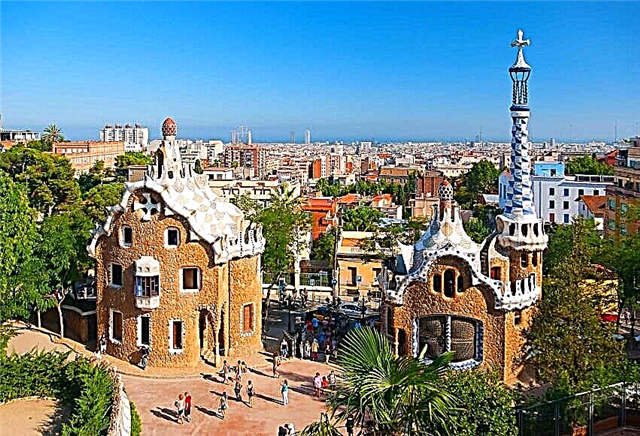Modern crocodiles are considered one of the oldest existing animal species - their ancestors appeared at least 80 million years ago. And although in their appearance crocodiles really resemble dinosaurs and other extinct animals, from the point of view of biology, birds are closest to crocodiles. It's just that the ancestors of birds, having got out on land, stayed there, and later learned to fly, and the ancestors of crocodiles returned to the water.
"Crocodile" is a generalized name. This is how crocodiles, alligators, and gharials are often called. There are differences between them, but they are rather insignificant - in gavials, the muzzle is narrower, longer and ends with a kind of thickening-knob. In alligators, the mouth, unlike crocodiles and gavials, closes completely.
There was a time when crocodiles were on the verge of extinction. To restore their numbers, crocodiles began to be bred on special farms, and gradually the danger of extinction that threatened the species disappeared. In Australia, reptiles have bred at all so that they already pose a danger to humans and animals.
More recently, humans have started keeping crocodiles as pets. This is not a cheap business (only the crocodile itself costs at least $ 1,000, and you also need rooms, water, food, ultraviolet light, and much more) and not very grateful - crocodiles are almost impossible to train, and you definitely cannot wait for tenderness or affection from them ... However, the demand for domestic crocodiles is growing. Here are some facts to help you get to know these reptiles better.
1. In ancient Egypt, the real cult of the crocodile reigned. The main god-crocodile was Sebek. Written references were also found about him, but more often Sebek can be seen in numerous drawings. During the construction of one of the canals in the Aswan area in the 1960s, the ruins of the temple of Sebek were found. There were premises for the keeping of the crocodile, appointed by the deity, and the habitation of his relatives. A whole incubator was found with the remains of eggs, and a semblance of a nursery - dozens of small pools for crocodiles. In general, the information of the ancient Greeks about the almost divine honors given by the Egyptians to crocodiles was confirmed. Later, the burials of thousands of mummies were also found. Initially, scientists suggested that behind the fabric of the mummy, from which the crocodile's head protrudes, there is a human body, as in numerous surviving drawings. However, after magnetic resonance imaging of the mummies, it turned out that full mummies of crocodiles were found in the burial. In total, in 4 places in Egypt, burials were discovered in which there were 10,000 crocodile mummies. Some of these mummies can now be seen in the museum in Kom Ombo.
2. Crocodiles in the water play the role of wolves in the forest. With the advent of mass firearms, they began to be exterminated for security reasons, and even crocodile skin became fashionable. And literally one or two decades was enough for fishermen to notice: no crocodiles - no fish. At least on a commercial scale. Crocodiles kill and eat, first of all, sick fish, protecting the rest of the population from epidemics. Plus population regulation - crocodiles live in waters great for many species of fish. If crocodiles do not exterminate part of the population, the fish begins to die from lack of food.
3. Crocodiles are an example of negative evolution (if, of course, it has a sign at all). Their ancient ancestors got out of the water onto land, but then something went wrong (possibly, as a result of the next warming, there was much more water on the Earth). The ancestors of crocodiles returned to the aquatic lifestyle. The bones of their upper palate have changed so that, when breathing, the air goes through the nostrils directly into the lungs, bypassing the mouth, allowing crocodiles to sit under water, leaving only the nostrils above the surface. There are also a number of signs established in the analysis of the development of the crocodile fetus, confirming the reverse nature of the development of the species.
4. The structure of the skull helps effective crocodile hunting. These reptiles have cavities under the scalp. On the surface, they are filled with air. If you need to dive, the crocodile inhales air from these cavities, the body acquires negative buoyancy and silently, without a splash characteristic of other animals, plunges under the water.

5. Crocodiles are cold-blooded animals, that is, to maintain their vital activity, they do not need so much food, given that they are predators. The opinion about the extraordinary gluttony of crocodiles appeared due to the nature of their hunt: a huge mouth, boiling water, a desperate struggle of the caught prey, throwing large fish into the air and other special effects. But even large crocodiles can go without food for weeks or be content with hidden leftovers. At the same time, they lose a significant - up to a third - part of their weight, but remain active and vigorous.
6. Lovers of nature in general and crocodiles in particular prefer to declare that crocodiles are not dangerous to humans in case of reasonable behavior of the latter. Here they are somewhat close to dog lovers, informing bitten people that dogs just don't bite people. The number of deaths in car accidents or the number of deaths from the flu is also good additional arguments - crocodiles eat fewer people. In reality, a man for a crocodile is a tasty prey, which, being in the water, can neither swim away nor run away. For example, one of the crocodile subspecies, the gavial, is famous for its clumsiness on land. Nevertheless, the gavial easily throws its 5 - 6 meter body forward, knocks the victim down with a blow of the tail and finishes the hunt with sharp teeth.
7. On January 14, 1945, the 36th Indian Infantry Brigade attacked Japanese positions on Ramri Island off the coast of Burma. The Japanese, left without artillery cover, under cover of night withdrew and evacuated from the island, leaving 22 wounded soldiers and 3 officers on it - all of them volunteers - as a cut-off ambush. For two days the British simulated attacks on well-fortified enemy positions, and when they saw that they were attacking the positions of the dead, they urgently composed a legend according to which Burmese crocodiles without a trace devoured more than 1,000 Japanese with weapons and ammunition, fleeing from the valiant enemy. The crocodile feast even made it into the Guinness Book of Records, although even some sane Britons still ask: who did the crocodiles eat before the Japanese on Ramri?
8. In China, one of the local subspecies of the crocodile, the Chinese alligator, is protected by both the International Red Book and local laws. Nevertheless, despite the ecologists' alarm (less than 200 alligators left in nature!), The meat of these reptiles is officially served in catering establishments. The enterprising Chinese breed alligators in national parks, then sell them as culls or extra offspring. The Red Book does not help those alligators who accidentally, in pursuit of a duck, wander into a rice field. The desire of alligators to constantly bury themselves in deep holes harms not only crops, but also numerous dams, so the Chinese peasants do not stand on ceremony with them.
9. There is no documentary evidence of the existence of giant crocodiles with a body length of more than 10 meters. Numerous stories, tales and “eyewitness accounts” are based only on oral stories or photos of dubious quality. This, of course, does not mean that such monsters do not live somewhere in the wilderness in Indonesia or Brazil and simply do not allow themselves to be measured. But if we talk about the confirmed sizes, then people have not yet seen crocodiles longer than 7 meters.
10. The appearance and disposition of crocodiles are exploited in dozens of feature films. These are mostly run-of-the-mill horror films with self-explanatory titles like Eaten Alive, Alligator: Mutant, Bloody Surfing, or Crocodile: Victim List. An entire franchise of six films has been filmed based on Lake Placid: The Lake of Fear. This film, filmed back in 1999, is also known for the minimal amount of computer graphics and special effects. The killer crocodile model was built in full size (according to the scenario, of course) and was equipped with a 300-horsepower engine.
11. The American state of Florida is a real paradise not only for people, but also for crocodiles and alligators (this, apparently, is generally the only place on Earth where these handsome men live nearby). Warm climate, humidity, an abundance of shallow lagoons and swamps, a lot of food in the form of fish and birds ... To attract tourists in Florida, several special parks have been created, offering interesting and sometimes dangerous attractions. In one of the parks, you can even feed huge reptiles with meat. Tourists are delighted, but for locals alligators are an everyday danger - it is not very pleasant to find a two-meter alligator lounging on the lawn or swimming in a pool. Not a single year in Florida goes by without death. Although they say that alligators kill people only to protect the eggs, their attacks annually claim the lives of 2-3 people.
12. The largest crocodiles - the ridged ones - have a fairly well developed communication. Observations and audio recordings showed that they exchange at least four groups of signals. Newly hatched crocodiles signal the light with one tone. Teenage crocodiles call for help with sounds similar to barking. The bass of adult males signals to a stranger that he is going to trespass the territory of another crocodile. Finally, crocodiles make a special type of sounds, working on the creation of offspring.
13. Female crocodiles lay several dozen eggs, but the survival rate of crocodiles is very low. Despite all the ferocity and invulnerability of adult crocodiles, their eggs and young animals are constantly being hunted. Attacks by birds, hyenas, monitor lizards, wild boars and pigs lead to the fact that about a fifth of the young live up to adolescence. And of those crocodiles that have grown to several years of life and a length of 1.5 m, barely 5% grow into adults. Crocodiles do not suffer from epidemics, but in especially humid and damp years, when water floods the nests and caves dug by alligators, predators remain without offspring - the crocodile embryo dies very quickly in salt water, both in the egg and after hatching from it.
14. Australians, as practice shows, experience teaches nothing. After all their vicissitudes of the struggle with rabbits, cats, ostriches, dogs, they did not close themselves in the inner endemic world. As soon as the world was preoccupied with the desire to save the combed crocodile from destruction, the Australians were again ahead of the rest. On the territory of the smallest continent, dozens of crocodile farms have been founded. As a result, by the beginning of the XXI century, half of the entire world population of salted crocodiles lived in Australia - 200,000 out of 400,000. The consequences were not long in coming. At first, livestock began to die, then it came to people. Climate change led to a change in the landscapes, and crocodiles began to flee from farms to more adapted places where people had the misfortune to live. Now the Australian government is hesitating between protecting helpless animals and protecting people, deciding whether to allow crocodile hunting, or everything will somehow go by itself.
15. In William Shakespeare's tragedy "Hamlet, Prince of Denmark", the protagonist, arguing with Laertes about love, passionately asks his opponent if he is ready to eat a crocodile for love. As we know, crocodile meat is more than edible, therefore, outside the realities of the Middle Ages, Hamlet's question sounds rather ridiculous. Moreover, he immediately asks Laertes if he is ready to drink vinegar, which is clearly dangerous to health. But Shakespeare was not wrong. In his time, that is, about 100 years later than the fictional Hamlet, there was a popular vow among lovers - to eat a stuffed crocodile, having previously stolen it from a pharmacist's shop. Such stuffed animals in the window were a hallmark of the pharmaceutical craft.
16. It is generally accepted that crocodiles have no enemies in nature, they are the top of the food chain. From the point of view of our notions that animals hunt solely for food, this is so. But crocodiles are fiercely, absolutely irrationally hated by elephants and hippos. Big savannahs, if they are lucky enough to cut off the crocodile from the reservoir and catch up with it, literally trample the reptile into the dust, only a blood stain remains. Hippos sometimes even throw themselves into the water, protecting an antelope or other animal from the attack of a crocodile. But in some areas of Africa, Nile crocodiles and hippos get along well even in the same reservoir.
17. The Chinese alligator practically disappeared from the Yangtze by the middle of the twentieth century - the Chinese lived too densely and poorly to allow “river dragons” to carry fish, birds and small livestock from them. Alligator stomach stones, which are valued as souvenirs, have become all the more valuable. Reptiles ingest these stones to regulate the body's balance in the water. Over the years, stones are polished to a mirror finish. Such a stone with a written, or better engraved, saying or poem is considered a wonderful gift. Alligator teeth are used for the same purpose.

18. Crocodiles do not have inflammation or gangrene even with the most terrible wounds, and in fact during the mating season they can spend up to an hour in the water. Even the ancient Chinese guessed that the blood of crocodiles has some special properties. Only in 1998, Australian scientists were able to establish that the blood of crocodiles contains antibodies that are thousands of times more active than their counterparts in human blood. The prospect of isolating these antibodies and using them in medicine is very tempting, but it will take decades at best.
19. The Chinese call the mind of the crocodile "slow" - the reptiles are practically impossible to train. At the same time, the inhabitants of the river banks of the Celestial Empire kept crocodiles as guards for centuries - on a chain not far from their home. That is, at a minimum level, a crocodile is able to understand the simplest things: after a certain sound, it will be fed, there is no need to touch small children and pets, who unknowingly fell into the reach. Numerous shows in Thailand show not trained whales, but live props. The temperature in the pool is lowered, plunging the crocodiles into a semi-drowsy state. The calmest crocodile is selected. The “trainer” constantly pours himself with water from the pool, leaving only the smell familiar to the crocodile. In an extreme case, before closing its mouth, the crocodile emits a slight joint click - the trainer, in the presence of a reaction system, can have time to pull his head out of the mouth. Recently shows with crocodiles have appeared in Russia. Their members say that they train crocodiles in the same way as other animals.
20. An alligator named Saturn lives in the Moscow Zoo. His biography may well become the plot of a novel or a movie. The Mississippi alligator was born in the United States and in 1936, as an adult, was donated to the Berlin Zoo. There he is rumored to have become a favorite of Adolf Hitler (Hitler really loved the Berlin Zoo, Saturn really lived in the Berlin Zoo - the facts end there). In 1945, the zoo was bombed, and almost all the inhabitants of the terrarium, their number was close to 50, died. Saturn was lucky to survive. The British military mission handed over the alligator to the Soviet Union.Saturn was placed in the Moscow Zoo, and even then the legend of Hitler's personal alligator turned to stone. In the 1960s, Saturn had a first girlfriend, also an American named Shipka. No matter how hard Saturn and Shipka worked, they did not get offspring - the female was sterile. The alligator grieved for a long time after her death, and even starved for some time. He got a new girlfriend only in the 21st century. Before her appearance, Saturn was almost killed by a collapsed ceiling slab. They threw stones and bottles at him, a couple of times the doctors barely managed to save the alligator. And in 1990, Saturn refused to move to a new spacious aviary, again almost starving himself. In recent years, Saturn has perceptibly aged and spends almost all of its time in sleep or motionless wakefulness.









